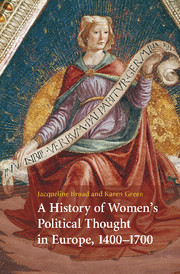Book contents
- Frontmatter
- Contents
- Preface
- Introduction
- 1 Christine de Pizan
- 2 Women of the Italian Renaissance
- 3 From Anne de Beaujeu to Marguerite de Navarre
- 4 Queen Elizabeth I of England
- 5 From the Reformation to Marie le Jars de Gournay
- 6 Women of the English civil war era
- 7 Quaker women
- 8 The Fronde and Madeleine de Scudéry
- 9 Margaret Cavendish, Duchess of Newcastle
- 10 Women of the Glorious Revolution
- 11 Women of late seventeenth-century France
- 12 Mary Astell
- Conclusion
- Bibliography
- Index
2 - Women of the Italian Renaissance
Published online by Cambridge University Press: 02 July 2009
- Frontmatter
- Contents
- Preface
- Introduction
- 1 Christine de Pizan
- 2 Women of the Italian Renaissance
- 3 From Anne de Beaujeu to Marguerite de Navarre
- 4 Queen Elizabeth I of England
- 5 From the Reformation to Marie le Jars de Gournay
- 6 Women of the English civil war era
- 7 Quaker women
- 8 The Fronde and Madeleine de Scudéry
- 9 Margaret Cavendish, Duchess of Newcastle
- 10 Women of the Glorious Revolution
- 11 Women of late seventeenth-century France
- 12 Mary Astell
- Conclusion
- Bibliography
- Index
Summary
Italy is universally acknowledged as the source of the European Renaissance, yet when one considers the trajectory of women's thought, France appears to have provided a more fertile intellectual context for women. This fact is paradoxical, for in the Italian city-states and principalities a significant number of women were provided with an excellent education that included training in Latin and occasionally even Greek and Hebrew. The numbers of such women were greater in Italy than in other European countries, and though women in France were literate in the vernacular, few wrote in Latin, perhaps because vernacular learning was established earlier in France. Christine de Pizan's father, Tomasso, may well have been following something of a Bolognese tradition when he gave his daughter an education approaching that of her brothers. In the north of Italy, and in Venice, Bologna, and Verona in particular, it was not completely unusual for the daughters of well-established noble and bourgeois families to be educated, and during the fifteenth century a good number of learned Italian women published letters, dialogues, and treatises. Christine reports that Novella Andrea, the daughter of a Bolognese legist, lectured at the university. This story is confirmed by other sources. Yet, from the point of view of the advancement of political themes, the known work of fifteenth-century Italian women is far less developed than Christine's.
- Type
- Chapter
- Information
- Publisher: Cambridge University PressPrint publication year: 2009

